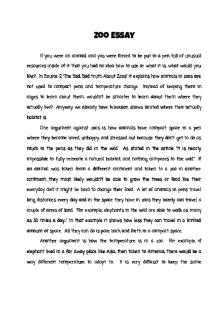Essay on Dna forms - Grade: B PDF

| Title | Essay on Dna forms - Grade: B |
|---|---|
| Course | An Introduction to Physiology |
| Institution | University of Leicester |
| Pages | 4 |
| File Size | 82.3 KB |
| File Type | |
| Total Downloads | 79 |
| Total Views | 142 |
Summary
ADNA ZDNA BDNA...
Description
“Describe the key features of the three-dimensional structure of the B-form of DNA. Discuss other three-dimensional structures that DNA may adopt and how these structures may affect its biological function.”
There are many forms of DNA which consists of A-form, B-form and Z-form. However, the most common is B-form as we have more knowledge about it due to the findings of Watson Crick. B-DNA is the basic structure of DNA which consists of two strands of DNA producing the shape of a double helix which is twisted like a ladder hold in place by the complementary base pairing of the nucleotides (A-T, C-G) in the middle that form simultaneously also with the aid of hydrogen bonds that form spontaneously. The other two forms A and Z are also quite different in their own way and they affect the function of DNA in a very similar way to B-form. B-DNA comprises of two strands which run along in the ‘5 – 3’ and the other strand in the ‘3 – 5’ as it is antiparallel. B-DNA is a right-handed form of DNA which consists of deoxyribose sugar linked to a phosphate molecule that goes on to produce phosphodiester bonds that connect on the 5’ prime end to 3’ prime end carbon due to the hydroxyl group on the 3rd carbon of the deoxyribose sugar which is removed during condensation reactions. These phosphodiester bonds tend to give DNA its strong structure also providing stability to the double helix (Steven Marr 2016). B-DNA also comprises of four nitrogenous bases which are connected to the first carbon on the deoxyribose sugar, these consist of Adenine, Thymine, Cytosine and Guanine which are complementary to each other and once they link together they form hydrogen bonds which provide stability in the middle of the double helix. The complementarity of these bases is essential for semi conservative replication (Mesleson and Stahl 1953) as it involves one of the strands acting as a template for the formation of the new strand to make a new strand of DNA. Meselson and Stahl discovered their finding of DNA being semi conservative replication by using nitrogen isotopes (N15 and N14). Due to the different densities of the isotopes they were able to discover that DNA is semi conservative. The thymine and cytosine only have one ring in their structure which gives them the name of pyrimidines whereas the adenine and guanine form two rings in their basic structure, so they are classed as purines. A purine is always complementary to its own pyrimidine (OpenStax College 2012). Once a purine and a pyrimidine link together hydrogen bonds form depending on which bases they are. So, for adenine and thymine only two hydrogen bonds are formed whereas if it is guanine and cytosine three hydrogen bonds are formed. Watson and Crick discovered the basic structure of DNA we all know as the B form. They found that DNA is a double stranded helix due to the clues of Rosalind Franklin also the Chargaff’s Rule. Rosalind Franklin worked with x-ray crystallography which lead her to producing the x-shaped diffraction image therefore this specific image was the major clue Watson and Crick discoveries that DNA is a double helix. The x-shape image 51 was formed by the rays deflected by the atoms in the crystal form and this created a fibre diffraction pattern that gave a major clue to the general molecule structure of DNA we all know now (Dr. Biology 2012) The Chargaff’s Rule was also another massive clue to Watson and Crick’s discoveries as it stated that there are always equal proportions of the nitrogenous bases in the DNA (A=T,
C=G). However, this rule mostly applied to a single strand of DNA also the amounts of the A, T, C, G bases found were not equal as it was predicted; moreover, the amounts varied among the species but not between individuals of the same species (D. R. Forsdyke 1995) The helical diameter of B-DNA is about 2.0 nanometres and 3.4 nanometres per turn consisting of about 10 nucleotides in that turn. Bonding of bases in B-DNA to the sugar phosphate backbone through glycocidic bonds is asymmetrical, this leads to the formation of grooves in the B-DNA. There is not a big difference between the grooves in B-DNA as they are quite similar in depth however a major and minor groove is formed due the major groove being a little wider and deep whereas the minor groove is narrow and deep (David Marcey 2003) There are also other forms of DNA that were discovered which were A-form and Z-form. ADNA is also right-handed just like B-form with a helical diameter of about 2.5 nanometres with a rise of 0.29 per base pairs consisting of 11 base pairs per turn. The A- form is made from B-form through dehydration reactions which are used to form the crystal structures of DNA. The A- form is a shorter and more compact helical structure of B-form however there is a slight difference in the grooves as the A-form has a major groove that is deep and narrow and a minor groove that is wide and shallow (Rosalind Franklin 1953). Z-DNA is quite the opposite to the other two forms as it is left-handed with a helical diameter of about 1.84 nanometres and a rise of about 0.37 per base pairs which makes it the form that contains more bases per turn compared to A and B- form as it has 12 bases per turn. Nevertheless, the grooves are also opposite as the major groove do9esnt exist at all and the minor groove is narrow and deep (Alan Herbert 1999). This Z-form was discovered by Alexander Rich, this was through his research which was based on self-complementary DNA hexamer. However, this lead on for him to discover this left-handed helix which consisted of two antiparareli strands hold in place by nitrogenous bases as proposed by Watson and Crick. The only difference from the B-form of Watson and Crick was that the bases rotated around the gycosidic bonds in the motion of anti and syn conformation. This overall formed a zig-zag pattern in the double helix structure which explains where the name Z-form is derived (Nicole Kresge 2009). One of the functions of A-DNA is in the sporulating bacteria where the DNA molecule binds to a protein causing the B-conformation to change into a A-DNA helix, this allows the bacteria to go into a safe state where it cannot be affected by heat, toxins, high pressures and all the genetic material is protected (David Ussery 2003). Nevertheless, Z-DNA main function has been found to be in the process of transcription as it is associated with the negative supercoiling for the RNA polymerase. Z-DNA is found in vivo in cells however their function is still not very clear, but Alexander Rich and Andres Wang came together and found that the Z-DNA is located at the start site of a gene therefore it may be involved in the role of regulation in gene expression. They also discovered that the double stranded enzyme ADAR1 specifically bind tightly to Z-DNA also the amounts of Z-DNA found in the cell nuclei correlated to the levels of RNA synthesis (Alexander Rich et al 2003)
These of forms of DNA A, B and Z are very important for the biological processes in each and every organism. Although the B-DNA is the most common form of DNA due to more scientific researches being accomplished and also the fact that it was the first form to be recognised and awarded for followed by the A- form which mostly explains why the main function of Z- DNA is still not very clear up to this day as not much research is being done on this form.
References: Rich, A. et al (2003) ‘Z-DNA: the long road to biological function’ Nature Reviews Genetics, 4 pp 566-572 Forsdyke, D (1995) ‘Relative roles of primary sequence and (G+C) % in determining the hierarchy of frequencies of complementary trinucleotide pairs in DNAs of different species’, Journal of Molecular Evolution, 41(5) pp 573-581 Ming Chu, T. (2018) ‘B-Form, A-Form, and Z-Form of DNA’ Available at: https://bio.libretexts.org/ Accessed: 18 October 2018 Kresge, N. et al (2009) ‘The discovery of DNA: the work of Alexander Rich’ Journal of Biol. Chem, 261, pp 6438-6443 Herbert, A. et al (1999) ‘Left handed Z-DNA: structure and function’ Genetica 106 pp 37-47 Marcey, D. (2003) ‘An introduction to DNA structure’ Available at http://earth.callutheran.edu Accessed: 15 October 2018 Khan Academy ‘Discovery of the structure of DNA’ Available: https://www.khanacademy.org/science/high-school-biology/hs-moleculargenetics/hs-discovery-and-structure-of-dna/a/discovery-of-the-structure-of-dna Accessed: 10 October 2018 Ussery, DW. (2002) ‘DNA Structure: A-, B-, and Z-DNA Helix Families’, Advances in Genome Biology pp 1-7 Meselson, M. and Stahl, FW. (1958) ‘The Replication of DNA’ Biol 23: pp 9-12 Dr. Biology (2012) ‘Rosalind Franklin- DNA’ Available at https://askabiologist.asu.edu/Rosalind_Franklin-DNA Accessed: 17 October 2018
Avissar, Y. et al (2012) Biology First Edition pp 37-43 Carr, SM. (2016) ‘The Watson-Crick Model 1953’ Available: https://www.mun.ca/biology/scarr/Watson-Crick_Model.html Accessed: 10 October 2018...
Similar Free PDFs

Essay on Dna forms - Grade: B
- 4 Pages

Essay on poverty - Grade: B
- 4 Pages

SO4032- Essay on Race - Grade: B
- 6 Pages

Rogerian Essay - Grade: B
- 2 Pages

Zoo Essay - Grade: B+
- 2 Pages

Causation Essay - Grade: B
- 4 Pages

Final Essay - Grade: B+
- 12 Pages

Propaganda Essay - Grade: b
- 4 Pages

Poetry Essay - Grade: B
- 5 Pages

Galileo Essay - Grade: B+
- 6 Pages

Fiction Essay - Grade: B
- 7 Pages

EPQ Essay - Grade: B+
- 10 Pages

Law essay - Grade: B
- 9 Pages

Persuasive Essay - Grade: B
- 3 Pages

Evicted Essay - Grade: B+
- 3 Pages

Charities essay - Grade: B+
- 13 Pages
Popular Institutions
- Tinajero National High School - Annex
- Politeknik Caltex Riau
- Yokohama City University
- SGT University
- University of Al-Qadisiyah
- Divine Word College of Vigan
- Techniek College Rotterdam
- Universidade de Santiago
- Universiti Teknologi MARA Cawangan Johor Kampus Pasir Gudang
- Poltekkes Kemenkes Yogyakarta
- Baguio City National High School
- Colegio san marcos
- preparatoria uno
- Centro de Bachillerato Tecnológico Industrial y de Servicios No. 107
- Dalian Maritime University
- Quang Trung Secondary School
- Colegio Tecnológico en Informática
- Corporación Regional de Educación Superior
- Grupo CEDVA
- Dar Al Uloom University
- Centro de Estudios Preuniversitarios de la Universidad Nacional de Ingeniería
- 上智大学
- Aakash International School, Nuna Majara
- San Felipe Neri Catholic School
- Kang Chiao International School - New Taipei City
- Misamis Occidental National High School
- Institución Educativa Escuela Normal Juan Ladrilleros
- Kolehiyo ng Pantukan
- Batanes State College
- Instituto Continental
- Sekolah Menengah Kejuruan Kesehatan Kaltara (Tarakan)
- Colegio de La Inmaculada Concepcion - Cebu